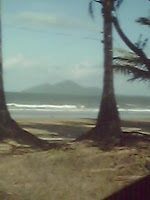

In 1913 Jose Paronella arrived in Australia from Catalonia, Spain. He spent the next eleven years cutting sugar cane, buying and improving and then re-selling cane farms. Jose returned to Spain in 1924 and the following year married his sweetheart, Margarita. Their honeymoon was a trip back to the shores of Australia. On this trip, Jose bought 13 acres of rainforest land at Mena creek for the price of 120 pound. It was then he started to build gardens and a reception centre for the public to enjoy.
The earliest structure, the Grand Staircase, was built to facilitate the carrying of the river sand to make the concrete. First they built a house to live in, then they started on the Castle itself. Apart from the house, which is made of stone, all of the structures were constructed of poured, reinforced concrete, the reinforcing being old railway track. The concrete was covered with a plaster made from clay and cement, which they put on by hand, leaving behind the prints of their fingers as a reminder of the work they had done.
The Park was officially opened to the public in 1935. The Theatre showed movies every Saturday night. In addition, with canvas chairs removed, the Hall was a favourite venue for dances and parties. During the sixties the Theatre ceased to be, the Hall then catered for functions, mainly weddings.
Above the Refreshment Rooms was the projection room, and up another flight of stairs was the Paronella Museum. This housed collections of coins, pistols, dolls, samples of North Queensland timbers and other items of interest. Originally, food service was from the lower Refreshment Rooms downstairs.

The Cottage - circa 1935's |
The concrete slab tables forming the lower Tea Gardens and the swimming pool both proved extremely popular, and are still utilised to this day. The avenues and paths are well laid out with planters which one can still see wherever you go in the Park. Two tennis courts were behind the Refreshment Rooms, with a children's playground, The Meadow, situated near the creek.
Upwards of 7000 trees were planted by José. These included the magnificent Kauris lining Kauri Avenue. A Tunnel was excavated through a small hill. Above its entrances are the delightful stonework balconies. Walking through here brings you to spring fed Teresa Falls, named for his daughter.
The creek is lined with rocks and traversed by small bridges. Some parts have cascades built out of rocks, so the sound of water is always there. The Hydro Electric generating plant, commissioned in 1933, was the earliest in North Queensland, and supplied power to the entire Park.

The Castle - circa 1935's |
In 1946, disaster struck. Upstream from the Park a patch of scrub had been cleared and the logs and branches pushed into the creek. When the first rains of the Wet Season came, the whole mass began to move downstream until it piled up against a railway bridge a few hundred metres from the Castle. Water backed up until the weight broke the bridge, and the entire mass descended on the Park. The downstairs Refreshment Rooms were all but destroyed, the Hydro was extensively damaged, as was the Theatre and Foyer.
Undaunted, the family began the task of rebuilding. The Refreshment Rooms downstairs were beyond repair, so this service was moved upstairs, and only the structure of the building recreated. In addition, José built the fountain. The Castle was repaired, the gardens replanted, and the Park was alive again.
In 1948, José died of cancer, leaving Margarita, daughter Teresa, and son Joe, to carry on. In time, Teresa married and eventually moved to Brisbane with her husband. Joe married Val in 1952, and they had two sons, Joe (José) and Kerry. Renovations and maintenance meant there was always plenty of work, and the floods of 1967, '72 and '74 further added to the load. In 1967 Margarita died, and in 1972, Joe died, leaving Val and the two boys to continue the hard working tradition and keep the dreams alive.
 The Park was sold out of the family in 1977 and sadly, in 1979, a fire swept through the Castle. For a time, the Park was closed to the public. Cyclone Winifred in 1986 and a flood in January 1994 reminded us yet again that Nature always has the upper hand.
The Park was sold out of the family in 1977 and sadly, in 1979, a fire swept through the Castle. For a time, the Park was closed to the public. Cyclone Winifred in 1986 and a flood in January 1994 reminded us yet again that Nature always has the upper hand.
The current owner/operators, purchased the Park in 1993 and formulated a plan to put the Park back on the map. They see the Park as a work of art, and are maintaining and preserving, rather than rebuilding. Small restoration projects have been undertaken, pathways uncovered and improved, and the Museum, an ongoing project, is continuously being enhanced.
The Park gained National Trust listing in 1997, and has been recognised by a total of 11 Tourism Awards in the period from 1998 till April 2000.
At the top of the waterfall, is a swinging bridge where you can look down onto the moss covered stone tables and seats. A walk through Paronella takes you to a that is filled with a sense of romance and mystery. I have been in here many times before it became a viable tourist destination and the atmosphere is almost magical. It is a great place to get lost in your own thoughts. Paronella Park is 10 minutes by car from where I currently live.
satisfágame aquí, como usted desea
PARONELLA PARK























































